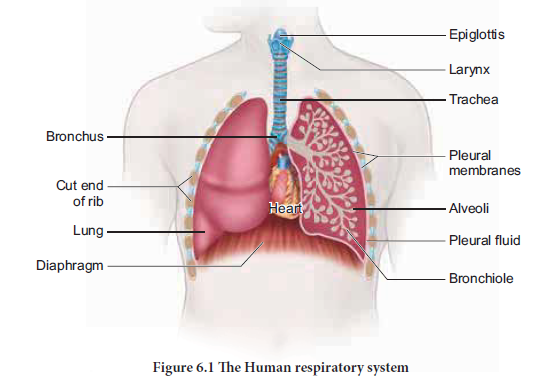• Learns to describe the gross structure of the human gaseous exchange system
• Observes and draws the tissues and organs associated with the respiratory system
• Understands the process of gaseous exchange and transport of respiratory gases
• Knows the problems associated with oxygen transport
• Gains knowledge on the ill–effects of smoking.
We inhale and exhale air. Why is breathing so important for life? What happens when we breathe? Why energy is required for the body to perform various life processes?
Where does the energy come from? We eat food for energy. Though the above raised questions look disconnected, we should know that the process of breathing is connected to the process of release of energy from food. Oxygen is utilized by the organisms to breakdown the biomolecules like glucose and to derive energy. During this breakdown carbondioxide, which is a harmful gas is also released. It is very obvious that oxygen has to be provided to cells continuously and the CO2 to be released immediately by the cells. So the need of a respiratory system is essential for life.
We have discussed in the previous chapter how food provides energy for growth and repair of tissues. As mentioned earlier along with food, oxygen is necessary for breakdown of glucose to energy. In this chapter we shall discuss the respiratory organs of human, the mechanism of breathing, exchange and transport of gases and a few respiratory disorders.
The term respiration refers to the exchange of oxygen and carbondioxide between environment and cells of our body where organic nutrients are broken down enzymatically to release energy.
6.1 Respiratory functions
The five primary functions of the respiratory system are –
i. To exchange O2 and CO2 between the atmosphere and the blood.
ii. To maintain homeostatic regulation of body pH.
iii. To protect us from inhaled pathogens and pollutants.
iv. To maintain the vocal cords for normal communication (vocalization).
v. To remove the heat produced during cellular respiration through breathing.
6.2 Respiratory organs in various organisms.
Different animals have different organs for exchange of gases, depending upon their habitats and levels of organization.The amount of dissolved oxygen is very low in water compared to the amount of oxygen in the air. So the rate of breathing in aquatic organisms is much faster than land animals.In animals like sponges, coelenterates and flatworms exchange of gases takes place through the body surface by simple diffusion. Earthworms use their moist skin, whereas insects have tracheal tubes.Gills are used as respiratory organs in most of the aquatic Arthropods and Molluscs. Among verterbrates, fishes use gills whereas amphibians, reptiles, birds and mammals have well vascularised lungs. Frogs spend most of their time in water and also use their moist skin for respiration along with lungs.
6.2.1 Human Respiratory System
The respiratory system includes the external nostrils, nasal cavity, the pharynx, the larynx, the trachea, the bronchi and bronchioles and the lungs which contain the alveoli (Figure 6.1). The parts starting from the external nostrils up to the terminal bronchioles constitute the conducting zone, whereas the alveoli and the ducts are called the respiratory zone. The parts of the conducting zone, humidifies and warms the incoming air. In human beings, air enters the upper respiratory tract through the external nostrils. The air passing through the nostrils is filtered by fine hairs and mucus lining the passage. The external nostrils lead to the nasal chamber which opens into the nasopharynx which opens through the glottis of the larynx region into the trachea. The ciliated epithelial cells lining the trachea, bronchi and bronchioles secrete mucus. Mucus membrane lining the airway contains goblet cells which secrete mucus, a slimy material rich in glycoprotein. Microorganisms and dust particles attach in the mucus films and

are carried upwards to pass down the gullet during normal swallowing. During swallowing a thin elastic flap called epiglottis prevents the food from entering into the larynx and avoids choking of food.
The trachea is semiflexible tube supported by multiple cartilaginous rings which extends up to the midthoracic cavity and at the level of the 5th thoracic vertebra where it divides into right and left primary bronchi, one bronchus to each lung. Within the lungs the bronchi divides repeatedly into secondary and tertiary bronchi and further divides into terminal bronchioles and respiratory bronchioles.
It is advised not to talk or laugh louder while eating. Can you give the reason?
Bronchi have ‘C’ shaped curved cartilage plates to ensure that the air passage does not collapse or burst as the air pressure changes during breathing.The bronchioles are without cartilaginous rings and have rigidity that prevent them from collapsing but are surrounded by smooth muscle which contracts or relaxes to adjust the diameter of these airways.
The fine respiratory bronchioles terminate into highly vascularised thin walled pouch like air sacs called alveoli meant for gaseous exchange (Figure 6.2, 6.3). The diffusion membrane of alveolus is made up of three layers – the thin squamous epithelial cells of the alveoli, the endothelium of the alveolar capillaries and the basement substance found in between them. The thin squamous epithelial cells of the alveoli are composed of Type I and

